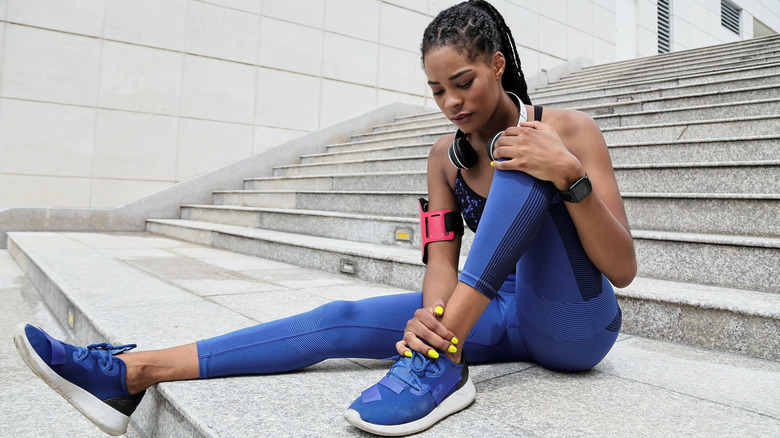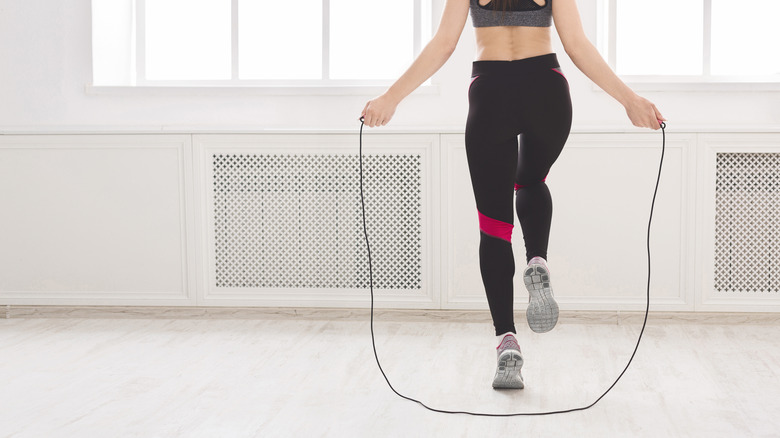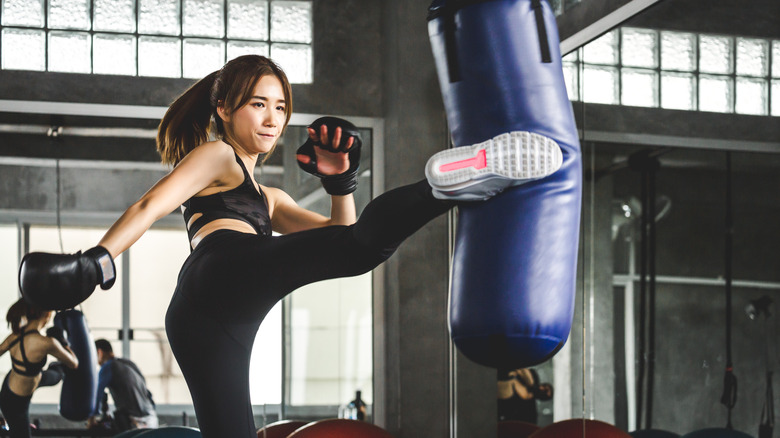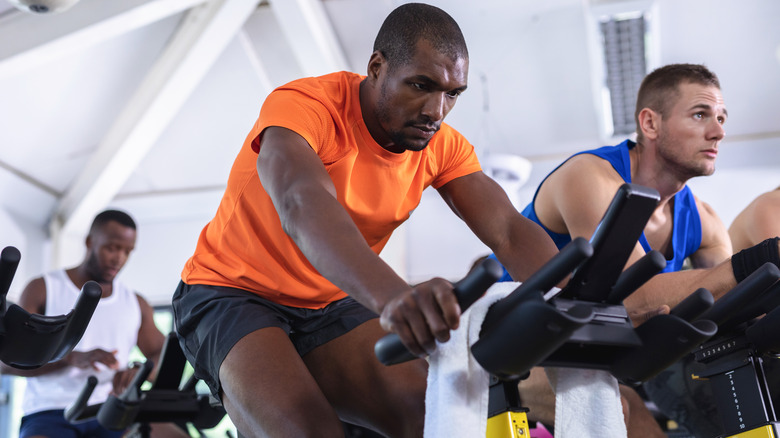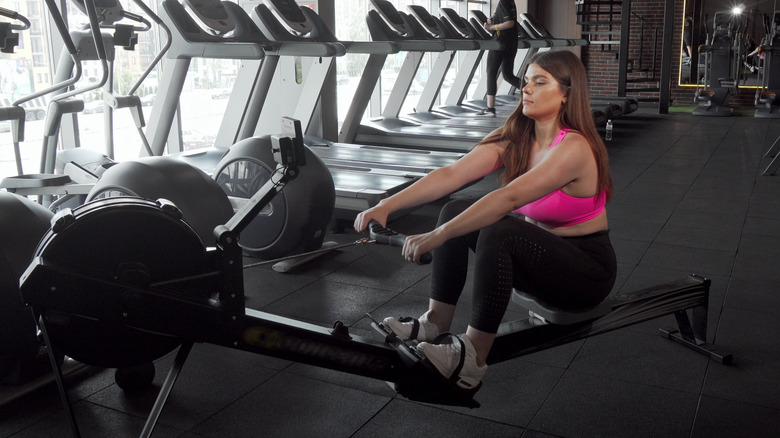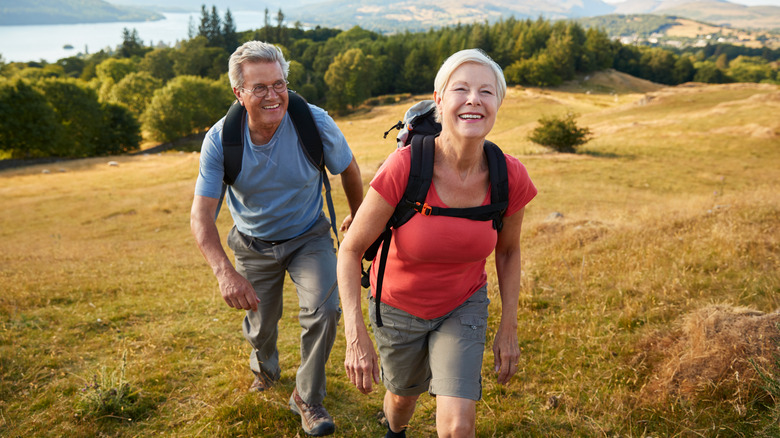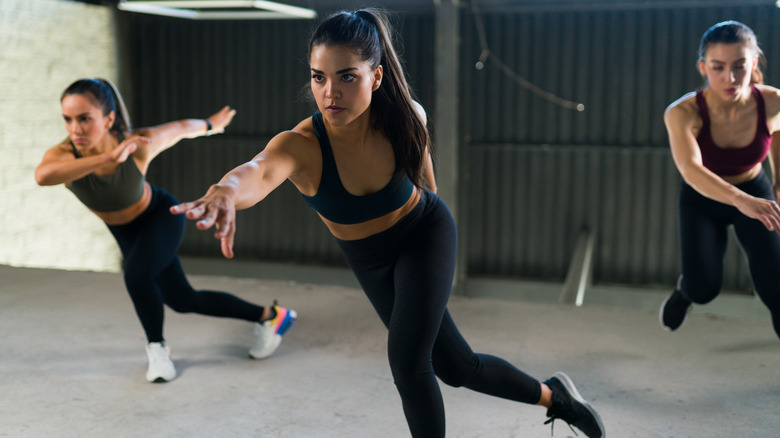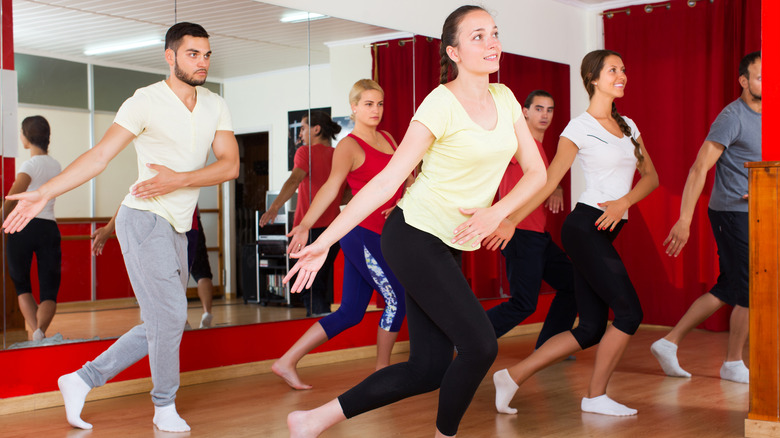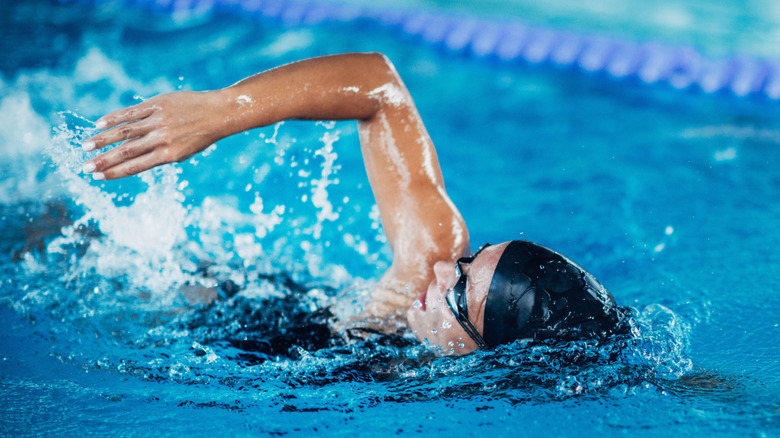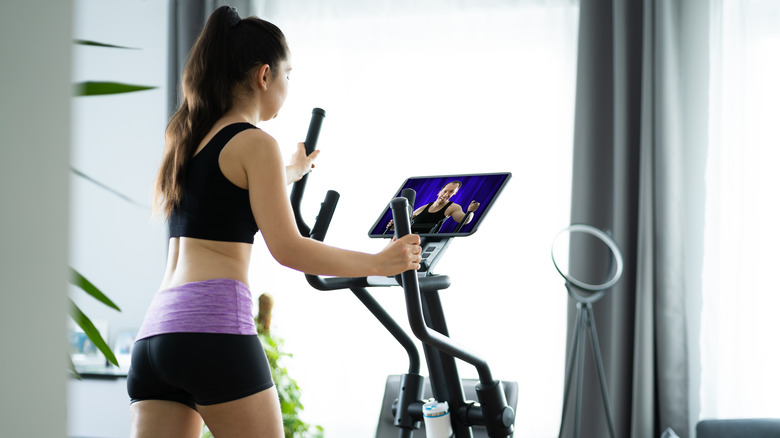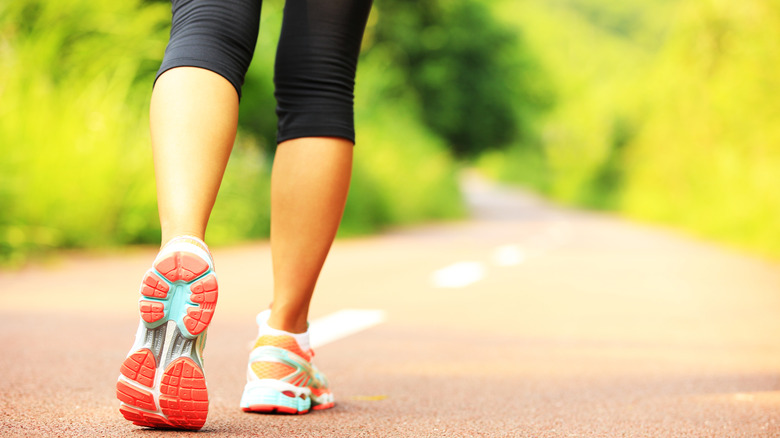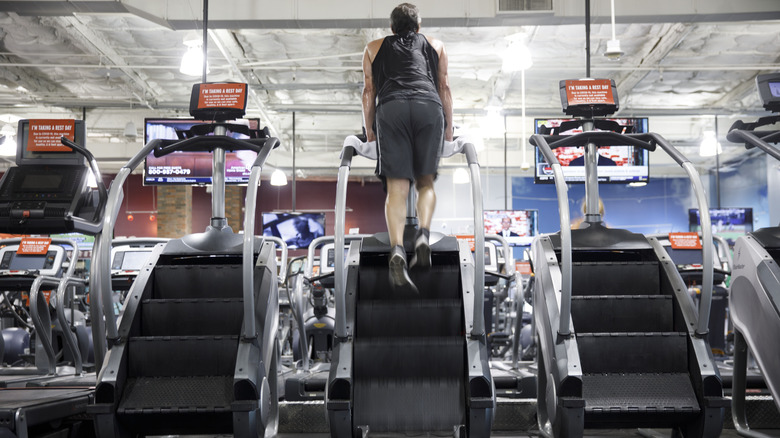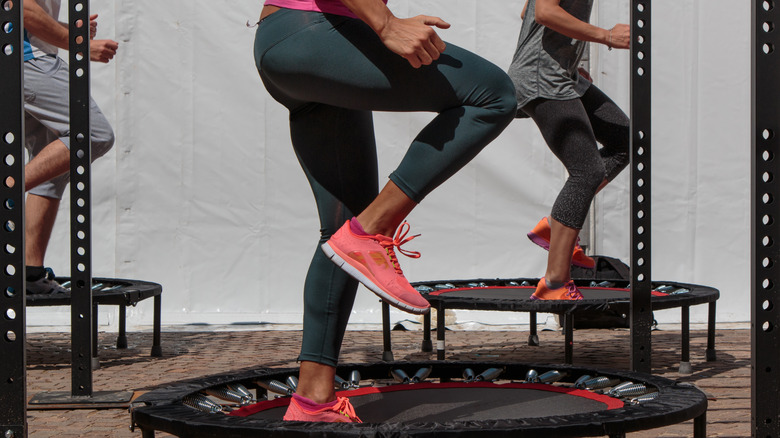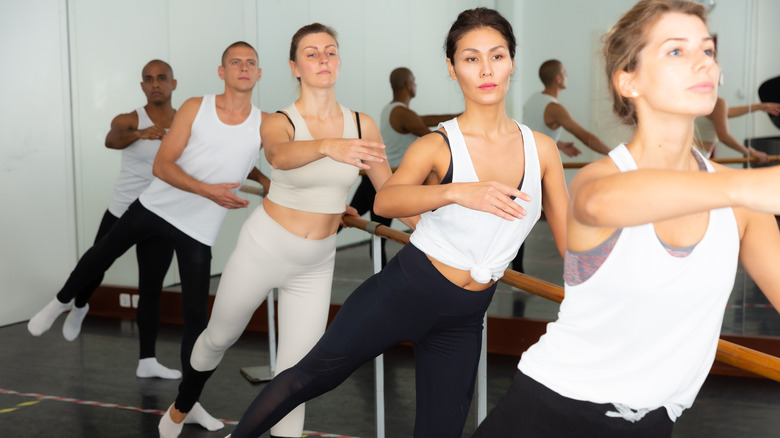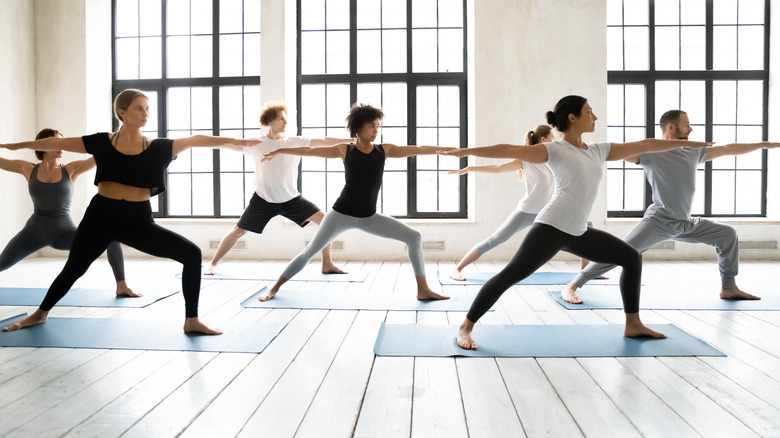The Best Workouts For People Who Hate Running
Running is a great cardio workout — there's no doubt about that — but the truth is, not everyone likes to run. In fact, some people despise running and will do anything to avoid it. And even some people who enjoy running don't want to do it all the time. While running has many health benefits, it also has its downfalls as it is a high-impact exercise that places pressure on our joints, potentially causing shin splints (via Runners World). And there are also some people who simply can't run due to an injury, chronic pain, or mobility issue that makes running extremely uncomfortable. But the good news is that there are so many workouts outside of running that have similar cardiovascular benefits and other perks.
There really is something for everyone when it comes to cardio. Non-runners just have to be open to giving them a shot. Not sure where to start? Let's take a look at the best workouts for people who are run-averse.
Jumping rope burns more calories than running
Running may be one of the most popular forms of cardio, but there are some underrated forms of cardio that actually may be even more effective than running, like jumping rope. According to a 2013 study in American Association for Health, Physical Education and Recreation, 10 minutes of jumping rope per day over the course of six weeks had an equal impact on cardiovascular fitness as 30 minutes of jogging. Another study also noted that jumping rope can improve young athletes' motor skills.
Celebrity trainer Jillian Michaels told Insider about some specific benefits of jumping rope, saying that it burns calories, strengthens coordination, reduces your risk of injury, and can even decrease your risk of heart disease.
And if you hate running, you're in luck because jumping rope actually burns more calories, according to Michaels. Michael suggests incorporating jumping rope into your exercise starting in shorter increments and building your way up. She also noted that you don't have to jump rope for 10 minutes straight to see the benefits. You can break it up into smaller sets between rounds of strength training.
Kickboxing is a great workout for your body and your brain
Unlike running, kickboxing is more than just cardio. It's an endurance, speed, and power workout all in one. According to a 2014 study published in the Muscles, Ligaments and Tendons Journal, kickboxing can improve "upper-body muscle power, aerobic power, anaerobic fitness, flexibility, speed and agility after training."
Martin "Marty" Kelly, a certified personal trainer and boxing expert, told Byrdie that kickboxing is the perfect workout if you're trying to tone your entire body. Kelly said, "The use of these moves in conjunction with one another strengthens muscles while reducing body fat, which creates that 'toned' body."
And kickboxing isn't only good for your body, it's also good for your brain. Kickboxing can relieve stress and decrease feelings of anxiety and depression (via Harper's Bazaar). Kelly told Byrdie, "I've had so many people come in to train and they become a different person when they leave. It's like a therapy session; they get all the bad energy out when they are punching a bag or hitting mitts." If you can't get to a kickboxing studio or gym, that doesn't mean you can't kickbox. One of the best parts about kickboxing is it can be done anywhere, including from the comfort of your home. There are plenty of classes available online and on-demand that you can take anywhere.
Spinning is an effective, low-impact workout
Spinning and cycling (both indoor and outdoor) have always been a popular, lower-impact alternatives to running. And as more at-home spin bikes and spin classes shoot to popularity, people's love for spinning seems to be increasing every day. Thankfully, certified personal trainer Remy Kam said that spinning is the perfect cardio substitute to running. She told Health Digest that in addition to cardio, "it includes added resistance to build your glute and quad muscles." Kam also noted that spinning has a lower impact on your joints compared to running, so it's ideal for people who want a cardio workout without having to put too much stress on their joints.
And if you're spinning in hopes of burning calories and losing weight, you should know that a 2018 study published in the Journal of Strength and Conditioning Research found that spinning combined with strength training was enough to have a positive effect on endurance and strength without changing dietary habits. Obviously, eating a healthy, well-balanced diet is always important when looking at our overall health, but spinning can definitely be the cardio kickstart you've been looking for.
Unlike running, rowing uses the majority of muscles in your body
You don't have to be an Olympic rower to reap the benefits of rowing thanks to rowing machines. Rowing machines, aka ergometers, give you a full-body workout that beats out most other forms of cardio. According to Healthline, rowing machines use up to 86% of your muscles. So it's not only a great cardio workout or an exercise that solely strengthens your arms, but it strengthens most of your muscles.
Rowing instructor Annie Mulgrew told Women's Health confirmed that, when rowing, "the major muscles in your legs, arms, back and core all must activate, providing a total body workout that will increase your body strength as well as your cardiovascular capacity." Sounds like a pretty great replacement for running if you ask us!
And as if all of that wasn't enough to get you excited about hopping on a rowing machine, it has minimal impact on your joints. Rowing instructor Chris Heron told Women's Health, "With a rowing machine you can work at the highest intensity you like, with the lowest impact on your body. I get so many people who do high-intensity treadmill workouts who have injured their ankles and knees by running too far, too quickly." So even if you happen to like running, mixing in rowing every once in a while could be beneficial for working more muscle groups without the impact on your joints.
Hiking is good for your physical and mental health
While running might not be for you, don't discount hiking just yet. It's another great way to get a cardio workout and get outside. According to WebMD, hiking can help you build strength, boost your bone density, improve your balance, improve your blood pressure, and reduce your risk of heart disease.
WebMD noted that even if you're starting small and hiking on hills, you'll still be reaping the benefits of hiking. Dr. Gregory A. Miller, president of the American Hiking Society, told the outlet that even as small as a 5% or 10% incline leads to burning 30% to 40% more calories. Eventually, building up to hiking on uneven terrain can improve balance and stability.
And on top of hiking being a great cardio workout, it's also equally good for your mind. Miller said that, "Research shows that hiking has a positive impact on combating the symptoms of stress and anxiety. Being in nature is ingrained in our DNA, and we sometimes forget that." One thing to note when hiking is you should bring a hiking buddy with you at first while you familiarize yourself with the trails and terrain. As you become a stronger hiker, you might feel more comfortable heading out for hikes on your own.
HIIT gives you a great workout in a short period of time
HIIT is all the craze in the fitness world and it's with good reason. HIIT stands for high-intensity interval training, this means the workout alternates between intense bursts of activity and set periods of less-intense activity or complete recovery.
Certified personal trainer and Barry's Bootcamp instructor Remy Kam spoke to Health Digest about why HIIT training is just as good for you as running. She said, "Just like running, HIIT gets your heart rate up and improves endurance. It is more fun because it includes cardio in intervals combined with strength exercises, so you get to focus on building muscle too."
Kam also noted that if you have a busy lifestyle, HIIT can be extremely effective in just a short amount of time adding, "This makes it easier to consistently integrate into your daily routine and therefore more effective." And the proof is in the results. According to a study published in The Journal of Physiology, subjects could bicycle two times as long as usual after completing eight weeks of HIIT workouts, while maintaining the same pace.
Dancing is a great workout and a great way to make friends
You don't have to be a professional dancer or even a good dancer to enjoy the benefits dancing has on the body. According to Everyday Health, dancing is a great cardio workout that can help you lose weight, stay flexible, reduce stress, improve your balance, and even improve your memory. Remembering all those moves can keep your brain healthy and active while you're moving your body. Kelsey Sheahan, an iFit trainer, told Greatist, "In my opinion, there is no better workout than dance. You have to use every essence of your body to do it. Dancing is a full-body workout in the truest sense." She added that dancing also improves your mood — because who isn't happy when they're dancing, right?
With that happiness boost, you might even meet some other happy people along the way. Everyday Health reports that dance classes are a popular place to make new friends and that can also benefit your health. According to the outlet, "Being socially engaged leads to increased happiness, reduced stress, and a stronger immune system."
Your body works harder in less time when swimming
Regardless of your fitness level, swimming is a great full body workout that burns as many calories as running without the impact on your bones and joints. According to the Centers for Disease Control and Prevention, swimming is the fourth most popular sports activity in the United States. Swimming.org revealed that swimming is not only an effective full-body workout, but it's a more effective exercise than running. The outlet noted, "Exercising in water makes your body work harder so 30 minutes in a pool is worth 45 minutes of the same activity on land." And because swimming has such a low impact on joints and bones, it's a great way to get back into exercise while recovering from an injury.
Swimming.org revealed that "water supports 90 percent of the body's weight" so you won't be putting any significant weight on injured or sore body parts. And the best part of swimming? Well, if you hate the sweaty part of working out, you're in luck. No matter how hard you work out, the water will always be all around you cooling you off and keeping you from having sweaty clothes stick to your body.
Elliptical training is way less intimidating than running on a treadmill
If you hate running outside, you may also not be inclined to try the treadmill at the gym. Thankfully, that's where the elliptical comes in. The elliptical provides a low-impact, full-body workout — all without lifting your feet from the pedals.
The elliptical provides an effective cardio workout for people of all ages and fitness levels and isn't as intimidating as some other cardio machines. Certified personal trainer Amie Hoff told Greatist that it's great for gym newbies, saying, "It's a very easy motion and can give people a sense of security." Luckily, pretty much every gym has elliptical machines so there's no excuse not to give one a try!
Although running may seem like a more effective cardio workout, believe it or not, multiple studies showed that the elliptical could be more beneficial than running on a treadmill. According to a 2010 study published in The Journal of Strength and Conditioning Research, your heart rate actually gets higher during elliptical training in comparison to treadmill training. This may be because ellipticals incorporate your arms as well as your legs. Another study also revealed that subjects felt more intense exertion on the elliptical compared to the treadmill.
Walking might be a better workout than running
You don't have to run to get the benefits of moving your body. Walking works too and has numerous health benefits for people of all ages and fitness levels. Certified personal trainer Remy Kam told Health Digest, "While walking might take longer to burn calories compared to running, it's lower-impact, requires little prep, and is very achievable." She also added that walking can easily be included in your daily routine compared to other workouts. If you can't necessarily dedicate time to working out, Kam suggests walking to run your errands, walking your dog, or taking a call on a walk just to get your body moving.
Dr. Matt Tanneberg, a sports chiropractor and certified strength and conditioning specialist, told NBC News that while people think running is a better workout because it's more physically demanding, "walking can be as good as a workout, if not better, than running." Plus, a study in the British Journal of Sports Medicine found that subjects who stuck to a walking program showed significant improvements in blood pressure, resting heart rate, body weight, cholesterol levels, endurance, and even mood. Kam noted that walking is not only beneficial for the body, but it also has a positive impact on mental health because walking can stimulate creativity, positivity, and self-confidence.
Compared to running, stair climbers are easier on your joints
Stair climbing is another form of cardio exercise that's proven to be just as effective, if not more effective, than running. You can climb on actual stairs or on a stair-climbing machine like a StairMaster. Exercise physiologist Heather Milton spoke to Women's Health about why working out on a StairMaster is a better lower-body workout than running. She explained, "You're able to work through a [large] range of motion at the hip and knee which can benefit your butt muscles, as well as the quadriceps, and hamstrings." Milton also added that stair climbers don't just work your lower body, but they also engage your core. For the best core workout on a StairMaster, don't hold onto the arm rails; instead, use your core to keep yourself upright and stable.
Unlike running or other cardio workouts like HIIT, stair climbing is considered to be pretty low impact. According to Women's Health, this will not only help ease pain on your ankles, knees, and hips in the moment, but it can also help keep them healthier over time. This also means that stair climbing is a great form of cardio for someone recovering from an injury, easing back into working out, or just getting started on their fitness journey. While they may look intimidating at first glance, they're actually one of the most effective workout machines out there.
Trampolining is fun and burns more calories than running
Jumping on a trampoline isn't just for kids. This fun activity is a great cardio workout for people of all ages. And if you hate running, you're in luck because you can actually get a better workout on a trampoline. Fitness trainer and founder of the trampoline class Frame, Pip Black told Get The Gloss, "You burn more calories compared to jogging and it works wonders for the lymphatic system which in turn can help banish cellulite." Additionally, trampoline fitness instructor Colette Dong told Vogue, "It covers every single part of your body, and you can work up a massive sweat in just 30 minutes. It's efficient, but mainly it's fun."
You don't only have to jump on a giant trampoline to reap the benefits of trampolining, either. You can get a small trampoline, aka a rebounder, that you can use anywhere — even inside your home. According to Dong, "Rebounders are usually smaller and firmer, which allows for a better bounce when compared to a larger trampoline you might see outdoors." Dong also noted that the soft mat and cords of a trampoline make trampolining much easier on the joints than a sidewalk or roads you'd run on that have very little give.
You don't need to be a ballerina to get a great barre working
Barre is a ballet-inspired workout, yes, but don't worry: You don't need any ballet experience to reap the benefits from a barre workout. It's a low-impact strength workout that combines ballet movements with Pilates-style strength training and stretching similar to yoga. And you don't need an actual ballet barre to do barre classes; if you're doing classes at home you can use a counter or chair to hold onto for balance.
Dr. Michael Smith, a board-certified internal medicine physician, told WebMD, "Barre fitness is ideal if you're just getting into exercise. The classes will improve your balance, build strength, make you more flexible, burn calories, and improve stability through a stronger core." As for its impact on bones and joints, Dr. Smith noted that barre is gentle on the joints and is actually a great choice for people with conditions like arthritis. He said, "You'll also build stronger muscles, which gives more support to your joints and lessens pain."
Entire studios dedicated to barre classes, like Pure Barre and The Bar Method, have become more and more popular. So if you want to try barre in a group setting, a barre studio would be a great place to start. If that doesn't appeal to you, download a fitness app or stream an on-demand barre class.
You could see the benefits of yoga after just two classes
Yoga is an ancient practice that exercises both the body and the mind. It also happens to be a great alternative to running and an effective addition to any fitness routine. Yoga has countless physical and mental benefits, many of which are backed by science. Studies have shown the practice can reduce inflammation, decrease anxiety, and improve breathing. Dr. Natalie Nevins told the American Osteopathic Association that yoga can "lessen chronic pain, such as lower back pain, arthritis, headaches and carpal tunnel syndrome. Yoga can also lower blood pressure and reduce insomnia." The benefits list really does go on and on.
If you've never done yoga before, have no fear, you could start to see the benefits from practicing after just a couple classes. Yoga teacher Mary Beth LaRue told Byrdie that after just two classes, "physically you'll start to experience a sense of openness in your body. Perhaps it feels more spacious and flexible in areas that are usually tight and tense." And after the third or fourth class, you should start to see benefits like feeling stronger, sleeping better, and your skin could even have a new glow. Sounds like a great option for runners and non-runners alike!

